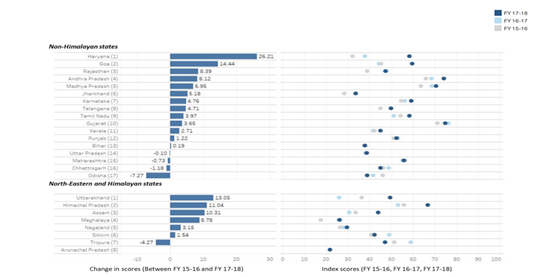
The issue of water governance in India has garnered increased attention, particularly considering recent findings by the World Bank (2023) highlighting the severity of water stress in the country. Despite India holding a mere 4% of the world’s water resources, it accommodates 18% of the global population. Also, India’s projected water demand is expected to increase two-fold by 2030, greatly surpassing the existing supply.
This stark incongruity has propelled India into the league of the world’s most water-stressed nations. However, the water crisis in India is not merely a matter of scarcity but also a systemic issue in mismanagement of water resources. A key challenge exacerbating India’s water woes is the phenomenon known as ‘hydro schizophrenia.’ This term encapsulates the disjointed relationship between the various entities responsible for water resource management, where different departments or agencies operate independently, often overlooking the broader implications of their actions. Mihir Shah (2019), a leading voice on India’s water issues, aptly stated that Hydro schizophrenia in India is not just a water crisis but a governance crisis. India’s decentralised approach to water governance, with states holding primary responsibility, leads to a fragmented management system. While the central government provides financial support for national projects, states have the autonomy to develop and manage water resources within their jurisdictions. This leads to divergent institutional frameworks and management practices across regions, aggravating issues related to property rights, and the tragedy of the commons in resource management, ultimately resulting in suboptimal resource allocation.
Fragmented Governance and the Tragedy of the Commons:
The prolonged Cauvery basin dispute between Karnataka and Tamil Nadu serves as a relevant case study, shedding light on the deep-seated hydro schizophrenia ingrained within India’s water governance structure. With water designated as a state subject in the Indian Constitution, conflicts stemming from interstate water disputes are exacerbated, creating what is often termed “conflictual federalism” (Ghosh and Modak, 2021). This framework hampers cohesive management efforts, causing tensions between states and impeding sustainable resource allocation (Ghosh and Bandyopadhyay, 2009). Drawing from the tragedy of the commons concept, the Cauvery dispute exemplifies how shared resources, such as water, are susceptible to overexploitation and degradation when individual states prioritise their immediate interests over long-term sustainability. Despite interventions by the Supreme Court to adjust water allocations and establish the Cauvery Water Management Authority (CWMA), fundamental ecosystem concerns within the basin remain unaddressed. Furthermore, the predominance of engineering professionals within the CWMA overlooks the multidimensional governance challenges of the basin, highlighting the need for a more interdisciplinary approach to water management. This narrow focus perpetuates the collective action problem, wherein individual state interests undermine optimal resource allocation and ecological conservation efforts.
Policy Initiatives and Institutional Reforms:
In response to these governance challenges, India has undertaken various policy initiatives and institutional reforms aimed at promoting sustainable water management. The establishment of the Ministry of Jal Shakti and the introduction of the Composite Water Management Index (CWMI) represent significant milestones in this regard.
The Ministry of Jal Shakti was established to centralise water management functions and streamline decision-making processes. By consolidating various water-related functions under one umbrella, the ministry aims to foster collaboration among states and promote accountability in water resource management. The introduction of the CWMI further enhances transparency and data-driven decision-making, providing states with valuable insights to refine their strategies for managing water resources effectively.
The CWMI (Figure 1) scores exhibit an uptrend from FY 2015 to 2018, indicating an escalating focus on water governance and heightened data discipline among states. By incentivising performance improvements and stimulating competition among states, the CWMI plays a pivotal role in orchestrating the judicious allocation of water resources while discouraging their over-exploitation.
Furthermore, the draft of National Water Policy (NWP) 2019 underscores the importance of a multidisciplinary and participatory approach to water management. By engaging experts from diverse fields and involving local communities in decision-making processes, the NWP seeks to foster collective action and ensure the sustainable use of water resources. Through collaborative partnerships and innovative strategies, the NWP aims to address the collective good aspect of water management, safeguarding water resources for future generations.
Change in Composite Water Index Scores

By incentivising performance improvements and stimulating competition among states, the CWMI plays a pivotal role in orchestrating the judicious allocation of water resources while discouraging their overexploitation. In this context, it addresses the underlying challenges associated with the tragedy of the commons, wherein shared resources are susceptible to degradation due to individual self-interests.
The new National Water Policy (NWP) draft by the Ministry of Jal Shakti in November 2019 marks a significant stride in confronting India’s water governance crisis. This policy underscores the imperative of establishing a unified National Water Commission (NWC) and advocates for a multidisciplinary, multi-stakeholder approach to water management. In tandem, the 2019 National Water Policy (NWP) underscores the significance of adopting a multidisciplinary and participatory approach to water management. Through the engagement of experts from diverse disciplines and collaboration with local communities, the policy endeavours to engender collective action and instil a sense of ownership over water resources. This collaborative paradigm is indispensable for addressing the collective good aspect of water management, wherein the benefits of conservation and sustainable use extend to society as a whole.
Conclusion
The lessons learned from the Cauvery dispute emphasise the importance of transitioning from engineering-centric to governance-focused approaches in India’s water management policies. This acknowledgment represents a significant first step in addressing institutional deficiencies and promoting inclusive decision-making processes. However, India must go beyond mere recognition and prioritise evidence-based, transparent, and accountable water governance practices. This entails establishing robust institutional mechanisms, fostering interdisciplinary collaboration among experts, and implementing standards for water resource management. By doing so, India can navigate water disputes more effectively and ensure sustainable water governance for the future.
In this regard, the National Water Policy (NWP) of 2019 plays a significant role by advocating for holistic and interdisciplinary approaches to water management. The NWP’s emphasis on inclusive decision-making and leveraging diverse expertise aligns with the lessons learned from the Cauvery dispute, signalling a positive shift towards governance-centric solutions. However, effective implementation and enforcement of the NWP are crucial to address the complex challenges posed by hydro schizophrenia and ensure sustainable water governance across India.

Author’s Bio: Ayushii Balutia holds a M.Sc degree in Public Policy and Management from the University of Glasgow. She works as a Research Associate at the Bharti Institute and actively volunteers with Women’s Enterprise Scotland, focusing on policy and research initiatives. A passionate advocate for Environmental, Social, and Governance (ESG) principles, Ayushii loves to read the works of roman philosophers, enjoys creative writing and dancing.
DISCLAIMER : The views expressed in this blog/article are author’s personal.

